I'm using a netgear WNDR4300 to run GraphicsMaigick to resize JPEG images. This is the cpuinfo,
cat /proc/cpuinfo
system type : Atheros AR9344 rev 2
machine : NETGEAR WNDR4300
processor : 0
cpu model : MIPS 74Kc V4.12
BogoMIPS : 278.93
wait instruction : yes
microsecond timers : yes
tlb_entries : 32
extra interrupt vector : yes
hardware watchpoint : yes, count: 4, address/irw mask: [0x0ffc, 0x0ffc, 0x0ffb, 0x0ffb]
isa : mips1 mips2 mips32r1 mips32r2
ASEs implemented : mips16 dsp dsp2
shadow register sets : 1
kscratch registers : 0
package : 0
core : 0
VCED exceptions : not available
VCEI exceptions : not available
It's very slow, and took over 4 minuntes for every photo.
root@OpenWrt:/mnt/sda1/media/# ll
drwxrwxrwx 2 root root 131072 Jun 10 14:07 ./
drwxrwxrwx 7 root root 131072 Jun 8 10:18 ../
-rwxrwxrwx 1 root root 4130026 Feb 10 2018 IMG_20180210_115807.jpg*
root@OpenWrt:/mnt/sda1/media/kidds# time gm mogrify -output-directory > /mnt/sda1/web -resize 64x64 -quality 75 IMG_20170628_100052.jpg
real 4m 19.72s
user 3m 21.86s
sys 0m 9.29s
UPDATE:
root@OpenWrt:~# gm identify -version
GraphicsMagick 1.3.31 2018-11-17 Q8 http://www.GraphicsMagick.org/
Copyright (C) 2002-2018 GraphicsMagick Group.
Additional copyrights and licenses apply to this software.
See http://www.GraphicsMagick.org/www/Copyright.html for details.
Feature Support:
Native Thread Safe yes
Large Files (> 32 bit) yes
Large Memory (> 32 bit) no
BZIP no
DPS no
FlashPix no
FreeType yes
Ghostscript (Library) no
JBIG no
JPEG-2000 no
JPEG yes
Little CMS no
Loadable Modules yes
OpenMP no
PNG yes
TIFF yes
TRIO no
UMEM no
WebP no
WMF no
X11 no
XML no
ZLIB yes
Host type: mips-openwrt-linux-gnu
Configured using the command:
./configure '--target=mips-openwrt-linux' '--host=mips-openwrt-linux' '--build=x86_64-pc-linux-gnu' '--program-prefix=' '--program-suffix=' '--prefix=/usr' '--exec-prefix=/usr' '--bindir=/usr/bin' '--sbindir=/usr/sbin' '--libexecdir=/usr/lib' '--sysconfdir=/etc' '--datadir=/usr/share' '--localstatedir=/var' '--mandir=/usr/man' '--infodir=/usr/info' '--disable-nls' '--enable-shared' '--disable-static' '--enable-dependency-tracking' '--with-modules' '--with-threads' '--without-magick-plus-plus' '--without-perl' '--without-bzlib' '--without-dps' '--without-fpx' '--without-jbig' '--without-webp' '--with-jpeg' '--without-jp2' '--without-lcms2' '--without-lzma' '--with-png' '--with-tiff' '--without-trio' '--with-ttf' '--without-umem' '--without-wmf' '--without-xml' '--with-zlib' '--without-zstd' '--without-x' 'build_alias=x86_64-pc-linux-gnu' 'host_alias=mips-openwrt-linux' 'target_alias=mips-openwrt-linux' 'CC=mips-openwrt-linux-musl-gcc' 'CFLAGS=-Os -pipe -mno-branch-likely -mips32r2 -mtune=24kc -fno-caller-save
Final Build Parameters:
CC = mips-openwrt-linux-musl-gcc
CFLAGS = -Os -pipe -mno-branch-likely -mips32r2 -mtune=24kc -fno-caller-saves -fno-plt -fhonour-copts -Wno-error=unused-but-set-variable -Wno-error=unused-result -msoft-float -mips16 -minterlink-mips16 -iremap/opt/buildbot/slaves/lede-slave-tah/mips_24kc/build/sdk/build_dir/target-mips_24kc_musl/GraphicsMagick-1.3.31:GraphicsMagick-1.3.31 -Wformat -Werror=format-security -fstack-protector -D_FORTIFY_SOURCE=1 -Wl,-z,now -Wl,-z,relro -flto -Wall
CPPFLAGS = -I/opt/buildbot/slaves/lede-slave-tah/mips_24kc/build/sdk/staging_dir/target-mips_24kc_musl/usr/include -I/opt/buildbot/slaves/lede-slave-tah/mips_24kc/build/sdk/staging_dir/target-mips_24kc_musl/include -I/opt/buildbot/slaves/lede-slave-tah/mips_24kc/build/sdk/staging_dir/toolchain-mips_24kc_gcc-7.4.0_musl/usr/include -I/opt/buildbot/slaves/lede-slave-tah/mips_24kc/build/sdk/staging_dir/toolchain-mips_24kc_gcc-7.4.0_musl/include/fortify -I/opt/buildbot/slaves/lede-slave-tah/mips_24kc/build/sdk/staging_dir/toolchain-mips_24kc_gcc-7.4.0_musl/include -I/opt/buildbot/slaves/lede-slave-tah/mips_24kc/build/sdk/staging_dir/target-mips_24kc_musl/usr/include/freetype2
CXX = mips-openwrt-linux-musl-g++
CXXFLAGS = -Os -pipe -mno-branch-likely -mips32r2 -mtune=24kc -fno-caller-saves -fno-plt -fhonour-copts -Wno-error=unused-but-set-variable -Wno-error=unused-result -msoft-float -mips16 -minterlink-mips16 -iremap/opt/buildbot/slaves/lede-slave-tah/mips_24kc/build/sdk/build_dir/target-mips_24kc_musl/GraphicsMagick-1.3.31:GraphicsMagick-1.3.31 -Wformat -Werror=format-security -fstack-protector -D_FORTIFY_SOURCE=1 -Wl,-z,now -Wl,-z,relro -flto
LDFLAGS = -L/opt/buildbot/slaves/lede-slave-tah/mips_24kc/build/sdk/staging_dir/target-mips_24kc_musl/usr/lib -L/opt/buildbot/slaves/lede-slave-tah/mips_24kc/build/sdk/staging_dir/target-mips_24kc_musl/lib -L/opt/buildbot/slaves/lede-slave-tah/mips_24kc/build/sdk/staging_dir/toolchain-mips_24kc_gcc-7.4.0_musl/usr/lib -L/opt/buildbot/slaves/lede-slave-tah/mips_24kc/build/sdk/staging_dir/toolchain-mips_24kc_gcc-7.4.0_musl/lib -znow -zrelro -L/opt/buildbot/slaves/lede-slave-tah/mips_24kc/build/sdk/staging_dir/target-mips_24kc_musl/usr/lib
LIBS = -lfreetype -lz -lltdl -lm -lpthread
UPDATE2: sample mode
root@OpenWrt:/mnt/sda1/media/kidds# time gm mogrify -output-directory /mnt/sda1/web -sample 64x64 -quality 75 IMG_20170628_100052.jpg
real 0m 20.76s
user 0m 8.70s
sys 0m 3.29s
Is there any way to improve the performance? I just want resize some photoes, if there is some library provided by MIPS, I can write a tool to call it using C language.


